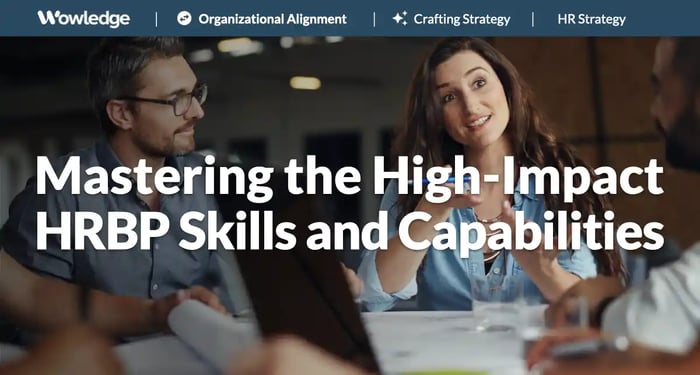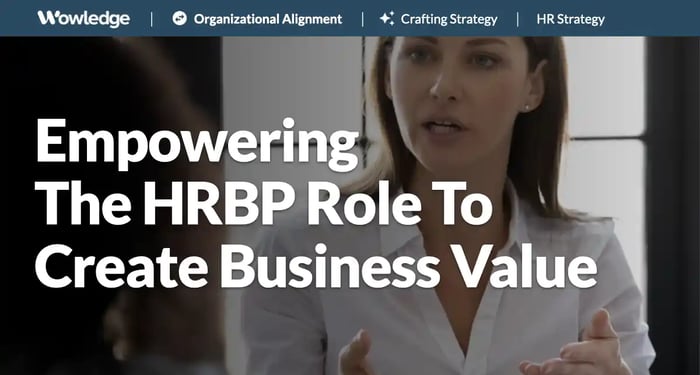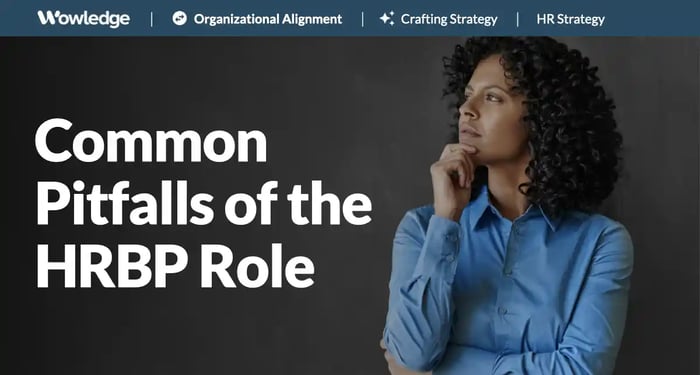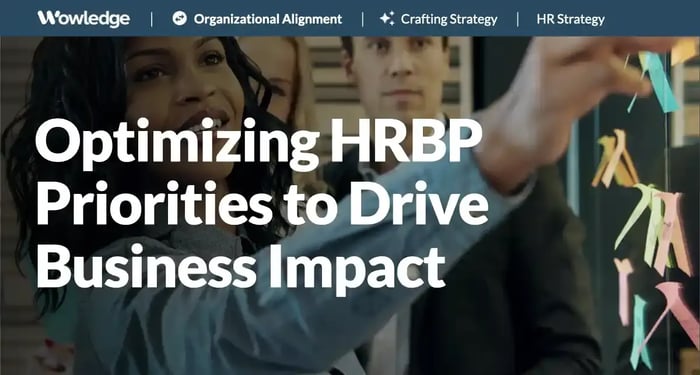Table of Contents
The HR business partner (HRBP) role is an essential element of fulfilling the strategic partnership capability that is core to the HR function’s value proposition. Regardless of the size, scale, or maturity level of any HR team, the objective of making a contribution to business success is always top of the list for HR leaders. This is the target for developing high-impact HRBP skills and capabilities. Unfortunately, however, most organizations experience a struggle to achieve the promise of that role, as research has found that HR Business Partners average 19 hours per week handling individual employee issues and 16 more hours on “daily operations”. The question this raises is whether those HRBPs are falling back and relying on dated skills as policy administrators and employee relations experts, or are all well-prepared but unable to exercise those strategic support muscles for the benefit of the business.
An answer can be found in industry studies, such as one that reported that only 24% of HRBPs partner with business leaders on solutions, and fewer than 15% of HRBPs have the skills required to redesign work or organizations. Even when the job is properly designed to focus on strategic business support, without proper HRBP skills and capabilities, their ability to effectively provide strategic support and solutions is unlikely.
The factors (and solutions) that drive HR Business Partners into the trap of doing non-strategic work fall into three consistent buckets:
- HR operating model and organization structure shortcomings. Unclear assignment of responsibilities for handling many of the daily challenges facing managers and employees, understaffing of HR support roles, and the reliance on technology that lacks or limits effective manager and employee self-service and support options.
- Historical and cultural limitations. An HR organization that lacks a track record of delivering strategic, business-aligned processes, solutions, and insights is constrained in its ability to make strategic contributions. Leaders and managers are less likely to invite or allow an assigned HRBP into strategic discussions without the trust that shared experiences and success normally bring.
- Undisciplined HRBP skills and capabilities development. The high-performance HRBP has business and HR expertise that is broad and deep. The time it takes to develop such capabilities, along with the skills to effectively manage the necessary relationships, assess, identify and create solutions, and coach and advise others with credibility, is substantial. It requires planning, resources, and motivated employees to successfully prepare and select people on a repeated and ongoing basis. This shortcoming is a chief culprit.
What differentiates high-quality HRBP performance
Although thousands of HR Business Partner jobs are posted and filled every year, the job duties and responsibilities of those vary widely in the portion of their work that involves strategic support. It is common to see employee relations issue resolution, employee benefits enrollments and questions, execution of programs created by COEs, and managing HR teams, all of which consistently restrict an HRBP's ability to generate and drive strategic business outcome-focused solutions.
A strict reading of the original intent, along with how leading practice organizations deploy people in this role, HR Business Partners are individual contributors aligned in a dedicated manner with a business unit or function’s leadership team, delivering strategic support free of day-to-day employee issue management. When considering the development of HRBP skills and capabilities, the job description and operating model should support staffing these roles accordingly.
When properly designed and deployed, organizations that develop and support high-performing HRBPs generate significantly improved employee performance by 22%, retention by 24%, corporate revenue by 7%, and profitability by 9%.
The key elements of mastering high-impact HRBP skills and capabilities should drive a focus on a number of critical success factors that differentiate the most effective performers from all other role holders.
Business expertise and acumen
The proximity to power and decision-making is always a primary allure of these jobs, but with the role comes a tremendous responsibility to have a deep understanding of the operations. Knowing what drives and impacts the unit’s finances, how the processes and workflows operate within and between departments and functions, the ways that the technologies are deployed and support (or drag) required outcomes, how customer value to defined and generated, and the ways that revenue is generated, sustained, and enhanced by marketing and sales strategies.
Relationships
The ability to build and maintain deep and trusted connections across the organization is an essential driver of HRBP success. The best leverage strong emotional intelligence and interpersonal skills to establish and build rapport and trust with leaders and their teams across the business, HR COEs, and Shared Services, other business functions (e.g., strategy, finance, IT, procurement, and security), and external sources of insight, support, and collaboration. The networking enables HR Business Partners to improve the linking of departments and functions to better align their efforts and levels of success with each other. It also supports the integration of leading HR practices and concepts to drive a culture that focuses employees on the organization’s mission, value proposition, customer requirements, and business and financial goals.
Coaching and advising
The skillful use of advanced coaching and consulting capabilities to build trust, establish credibility, and provide uniquely responsive support to the assigned business units. Leverages a broad range of experiences and HR expertise to guide leaders and their teams to better informed decision-making related to the deployment and management of the employees performing the needed work. Delivers advice and counseling that serves as effective role-modeling for leaders and supports their personal and professional development and growth. Uses business expertise to ask powerful questions that help leaders and managers find their own solutions that leverage their operational expertise from new perspectives, increasing ownership and likelihood of action.
Objectively-based decision support
The knowledge and expertise in using evidence-based HR and advanced analytics to move beyond “gut” or experience-based decision making into solutions that address the root causes of issues. Such data and fact-based decision support is an essential element as an organization grows, and the ability to directly oversee and manage large groups of employees. Even at 250-500 employees, the ability to look for and understand trends, breaking those down by employee type, level of experience, demographic, role, and function, location, and manager, becomes a true advantage to the HRBP and the leaders they support. The use of facts and objectively based insights can sway and motivate managerial acceptance of solution options developed with or by the HR Business Partner.
Foundational knowledge and expertise in all aspects of HR
HR Business Partners can be likened to basketball point guards, who identify opportunities to exploit and engage all other members of the team to create and execute winning plays. In that way, HRBP skills and capabilities development should be focused on supporting their ability to bring HR people and functions together to collaboratively build comprehensive solutions to organizational challenges. That requires an understanding of the value-adding elements, capabilities, and roles of each HR function, and how they can be integrated and leveraged together. Consider the following examples of HR capabilities that an HRBP might call upon when seeking to understand a problem and work collaboratively with their peer experts to respond to:
- Compensation – job analysis for identifying skills required for overlap or transferability with other job families, and those becoming obsolete for upskilling and workforce planning.
- Learning and development – how people best absorb information and process it, for use in determining the most effective and efficient way to reskill work teams, upskill employees with new technology adoptions, and support larger-scale change management efforts.
- Recruiting – aligning skills and proficiency requirements with operational requirements as they evolve with improved work methods, new product or service introductions.
A focus on operational success
Expertise in how to apply and adapt HR practices, processes, and programs to meet business and operational objectives. Starting with a deep understanding of how the assigned business operates and is led, collaborate with HR process owners to identify how to best tailor and refine HR capabilities to improve those outcomes. Continuously considers how performance management, workforce planning, organization capability development, and the cultural alignment of people can drive improvements in goal achievement. Considers the sources of organizational success, such as quality, productivity, customer service, cost management, innovation, collaboration, and goal alignment, as their primary job objective.
This focus leads to a continuous concentration on larger organizational issues that impact organizational success. Trends and challenges stemming from staffing shortages, skills obsolescence and replacement, AI co-working, change and disruption management, managerial skills deterioration, workplace stress, and cultural evolution are topics at the top of effective HRBPs' thoughts and planning.

The skills and traits of high-performing HRBPs
Mastering HRBP skills and capabilities should focus on enhancing the proficiency and on-the-job application of individual strengths that support those capabilities that differentiate top HR Business Partner contributors. Examples of critical ones include:
- Emotional intelligence (EQ) is the ability to recognize and self-regulate one’s emotions and those of others, using those to guide thinking and actions to achieve goals and build strong relationships. Includes listening and communication skills.
- Strategic thinking and action orientation, or the practice and ability to analyze the big picture, consider multiple factors, identify opportunities and challenges, and make decisions about future-focused objectives that can then be turned into action plans.
- Analytic and quantitative inclination, or the preference to rely upon data, statistical means, research, and other resources to generate more objective insights and plans.
- Curiosity and continuous learning drive a thirst for knowledge about how things work, what potentially useful concepts and practices are emerging, how others are facing challenges, and what approaches and tools can be used to resolve current or future issues. These inform resourcefulness and creativity in solution design and development.
- Collaboration is a mindset and motivation that is crucial for HRBP success. This supports the syndication and implementation of their ideas, innovations, and areas of expertise through trusted relationships across the enterprise.
- Managing ambiguity refers to a level of comfort with, and expectation for, facing the unknown as part of the job. It places them into a position of being a “calm and cool” voice and actor in times of organizational volatility and change, bringing well-considered perspectives and considerations to the leadership team.

Steps to take in mastering HRBP skills and capabilities
Leading HRBP skills and capability development practices involve a long-term commitment, as many elements of the differentiated HRBP require time to build. Even when hiring an external candidate to fill an immediate need, time is needed for them to build rapport and establish relationships, learn the basics of the organization’s financial and market success, and the nuances of its business processes. Developing the critical HRBP skills and capabilities for both new hires and internal candidates for the role should follow five (5) essential steps to help create a pool of candidates who are well-prepared for the rigors of the job.
1. Select the most suitable candidates
The best foundation for achieving mastery of high-impact HRBP skills and capabilities is to start with those who have demonstrated many or most of the traits, skills, and experiences required for success in the role. Whether considering external or internal candidates, the selection of HR Business Partners should be conducted with care, given their demonstrated ability to significantly impact employee performance and retention, as well as revenue growth and profitability. A solid foundation for job success is rooted in having the skills and traits outlined above, many of which can be assessed using formal, validated assessments. Consider candidates with substantial experience (12-15 years minimum) supporting businesses in a variety of roles, settings, stages of maturity (high growth, stability, downturn, turnaround), and industries.
2. Rotate job roles and functions to build depth and breadth
Rotating roles and functions within HR offer unique benefits and professional rounding for those in either generalist or specialized roles. Consider the value of a career lattice versus the career ladder approach, where different skills and experiences are developed and relied upon. The benefits of combining horizontal with lateral career movement enable the development of professional breadth and depth, a crucial approach in developing HRBP skills and capabilities.
The benefits of rotation for HR generalists come from the basic difference between supporting a single business unit or function and supporting all business units and functions. Generalists face a common challenge, which is the “jack of all trades, master of none” path that denies them the opportunity to develop depth in HR functional areas that can be primary challenges for organizations needing an HR Business Partner with strengths in certain areas. Specialist (COE, HRSS) roles demand an awareness of the full range of workers, types of work, and challenges faced, which immediately broadens the HR professional’s perspective and worldview on problem-solving. It also builds a sensitivity towards the need for tailoring programs, processes, and systems to accommodate the often-segmented needs of different businesses and the people they manage.
At the same time, rotations from specialist to generalist roles provide unique opportunities to work closely with business leaders and managers, understand the challenges they face, and identify areas where HR support is required. The generalist role exposes former specialists to the entire range of HR functions and capabilities, and helps them build skills related to strategic thinking, aligning HR practices and policies with business requirements, and adapting standardized practices to unique local needs.
3. Keep careers fresh and invigorated with role and function changes
Guiding HR professionals through long, productive, and satisfying careers involves continuous development. Working in the same or similar role, performing related tasks, and handling the same types and nature of problems and challenges for years can stifle growth and narrow perspectives. While the stability of knowing one’s role and responsibilities can be attractive to some, the “sameness” that can creep in is exacerbated by having the same status and relationships with HR peers, and line leaders, managers, and employees that come with each type of role.
The value of working in different HR roles and functions comes from exposure to new challenges and work methods, new and different relationships with stakeholders, and the development of broader skills in new applications. Rotations should be used throughout a career to keep even the most professionally seasoned and mature HR leaders and expert contributors fresh and reinvigorated with new challenges that stretch their intellectual and interpersonal skills and capabilities. Even changing major responsibilities within a role can invigorate with fresh challenges.
Consider the knowledge, experience, and skills that are differentially exercised and required for success in the three primary types of HR roles:
- Business partner or generalist. Direct support to an assigned business unit or function as an advisor or consultant (HRBP), leader (HR manager, director), or individual contributor (HR generalist, specialist, administrator). Each of these requires and develops knowledge and skills in business operations, strategic thinking and perspective, balancing business with human needs, applying HR concepts, policies, and tools to operational challenges, coaching and advising, motivating and engaging workers, and managing compliance with legal and regulatory policies, practices, and programs.
- Strategic Specialist. Design, development, and execution oversight for specialized HR programs and practices related to strategic planning or talent management. Center of Excellence (COE) related roles and teams develop and update both company-wide and tailored solutions in total rewards, recruiting, learning and development, health and safety, reporting and analysis, workforce planning, reporting and analytics development, and HR strategies. The skills applied and developed include strategy development, business strategy alignment, trend and issue analysis, creative and resourceful solution creation, project management, vendor and contractor management.
- Processing Expert. Management and processing of common and repeated organizational transactions, such as hiring, payroll processing, benefits enrollment, HR information systems management and optimization, compliance and legal reporting, data collection, data security and integrity, and employee inquiry support. Typically found in HR Shared Services in larger organizations, these roles focus on processing with standardization, efficiency, and cost-effectiveness. They develop knowledge and skills in technology configuration and deployment, process design and optimization, automation, transaction efficiency at scale, legal and regulatory compliance and reporting, data accuracy and integrity, and core analytic and reporting standards.
Leading practice suggests rotating HR leaders and professionals every 3 or 4 years, based upon a combination of their development needs (again, developing breadth and depth), skill and trait strengths, demonstrated learning agility and adaptability, and career aspirations.
4. Build and expand business knowledge and expertise
Continuous professional development is a requirement for any (current and future) HRBP, as advances in technology and industry, professional practices, and processes evolve and reset standards. Much like the need to stay abreast of changes in HR, mastering HRBP skills and capabilities should do the same, related to business and operational expertise. As part of the HRBP skills and capability development path, current and future HR Business Partners should focus on gaining expertise in:
- Where the business is headed and why – strategies, targets for research and development, future potential directions.
- How the company makes money – financial drivers and decisions, costs vs. revenue, sales process, customer support, and loyalty.
- What drives or derails productivity and quality – key elements of the human-machine connection, supply chain, design process, manufacturing enablers and derailers, distribution and delivery risks.
- Industry trends and standards – methods employed, product and services evolution, technologies adopted, competitive differentiators.
- How businesses in the industry grow – historical trends and case studies, expansion strategies and success factors, innovation opportunities, common missteps to avoid.
A key differentiator of high-performing HRBPs is the creation of expertise in the areas that are most valued by business leaders and managers. Demonstrating an interest and commitment to learning about their businesses, operations, and work methods enables the use of a shared vocabulary and understanding about the operational or business challenges facing them. Consider the value to an HRBP skills and capability development process of taking survey or introductory courses in finance, sales and marketing, supply chain, or operations management. Learning about topics such as advanced manufacturing, AI, robotics, blockchain, internet of things (IoT), cloud computing, augmented and virtual reality, and additive manufacturing can provide unique opportunities to contribute to strategic discussions and build added credibility.
5. Get involved in strategic planning and execution
Needless to say, the value of developing high-impact HRBP skills and capabilities through participation alongside business leaders and managers in strategic planning sessions, special projects (work process design and reengineering improvement, reorganizations), advanced operational skills training and development, or technology selection, configuration, and implementation efforts is substantial. The connections and shared experiences with internal clients, cross-functional peers, and outside experts can create strong bonds for future collaboration and influence.
Relevant Practices & Tools
Advanced HR Strategy Practices to Plan for Delivery of Impactful HR Services and Support. >
Advanced HR Strategy is a refined approach to planning long-term HR priorities. It involves increased specificity of plans and goals around key employee groupings... more »
Structuring the HR Organization to Best Meet Business Needs. >
The design of an HR organizational model requires considering a number of potential factors—the available HR budget, business organizational structure, business and HR strategic plans, critical workforce segments, and the company's culture... more »
Assessing Current and Future Skills-based Requirements and Gaps to be Filled. >
Bringing workforce planning into a skills-based level of assessment requires cataloging the skills required by the positions to be included, identifying the availability of those skills in the current workforce, determining future needs, and creating a gap analysis... more »
Creating a Culture of Internal Mobility that Supports Employee Development and Retention. >
Creating a culture of mobility requires management to accept that the benefits of movement (promotions and transfers) far outweigh the costs of replacing workers in their teams... more »
The Organizational Inventory and Talent Tracker Tool: Trace Individuals in the Organization During an Organizational Design Process. >
The tool helps identify the original role and reporting relationship(s) of all individuals in the organization, as well as their role and reporting relationship(s)... more »
About Wowledge
Wowledge is the implementation-first platform designed for lean HR teams and consultants who need to design and scale strategic HR programs efficiently—without starting from scratch.
Our members gain access to continuously updated best practices, step-by-step guidance, expert-built tools, and customizable templates—all structured to accelerate the development and implementation of key HR programs.
Recognizing that every organization operates at different levels of sophistication, Wowledge’s scalable system of best practices follows a stage-based approach—Core, Advanced, and Emerging—ensuring HR professionals can implement solutions tailored to their organization’s unique needs and goals.
Your Shortcut to Amplifying HR Impact!
Get started for FREE! Learn more.










